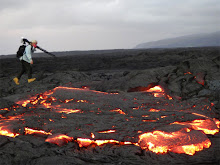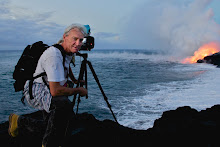
I took a break from my lave film editing (See lava movie update below) to trek out onto the flow. Taken yesterday, looking south-southeast from high on the Pulama Pali, about the 1600-ft elevation: these two photos show a very fast moving gusher of lava erupting from the tube system and snaking away as a 25-feet wide river down the pali. In the distance we see some of the coastal plain far below and a cloud-covered ocean beyond. This area is in the top section of the old Royal Gardens subdivision, (as more clearly located in the aerial further down the page)

My video of this
HERE~~~~~~~~

These creatively shaped pahoehoe formation (above & below) were taken at about the 800-foot elevation within Royal Gardens on the Pulama Pali. This lava was nearly red-hot and was just recently flowing; the downed trees along the top & edges are still burning. Later, just an hour after I left this area and was hiking the three miles out, I looked back to see a fresh breakout of pahoehoe pouring out over this spot- soon to be followed by a much broader area of breakouts as darkness set in. People at the Hawaii County viewing area could clearly see this show.

Click on any image to open them all on a viewer page.
From yesterday: a very cool (&hot) USGS/HVO aerial composite overlay of a thermal and daytime photograph of the Royal Gardens Subdivision area presently being overtaken by branching and widespread surface lava flows.

(USGS text in white-- my added notes are in green, yellow & black) -- click on it to read the text better) Active breakouts are shown in yellow, though the thermal imagery exaggerates what is actually flowing openly on the surface, I was there yesterday hiking all over it, as shown in my photos. Read the full thermal caption on their
images page.
Below: advancing a`a lava moving across an older lava flow:

And closer view:

Below: A ten-foot wide river of lava moving down the Pulama Pali yesterday at the 1400-ft elevation:

Swarms of small earthquakes have been recorded in the past few days. Most of these being concentrated only a few miles west-northwest of Halema’uma’u crater and Hawaii Volcanoes Park headquarters. About five of these were over 3.0 and two were over 4.0 (4.3 early yesterday morning).

Keep track of these on the interactive HVO earthquake page
hereEDIT TO FLATLINE report: I reported yesterday that the magma pressure graphs had flatlined. I was mistaken because I had not noticed that the radical tilt deformation graph scale had drastically changed to compensate for that long spike down anomaly, therefore giving the impression of being flatlined; I had not noticed the scale change. Thanks to Sagebrusher for alerting me to that oversight.
magma pressure deformation tilt monitors Lava Movie Update:
Lava Movie Update:On the advice of those in the know, I am making two version of the lava movie: one short, around 30 minutes and the other longer at around 45 minutes, which will allow for a broader avenue of distributing it later.
I just completed a nice draft of the shorter one; the longer version raw draft is basically complete. My co-editor I am hiring is unavailable for a while due to another project he is on so I am using my time to continue tweaking the two drafts.
Meanwhile I have written to the music composer’s producer/agent listing the compositions and lengths of the music I want to use for the movie; I am awaiting their reply. Buying the licenses to use these compositions will likely be quite costly, far higher than the editor will be, thus donations to the project are still very much appreciated!! (See Sidebar). Thanks so much to those of you who have so generously joined with me to help get this movie to the next level and out there to the world!!!
 Lava tube rupture forks out the top at rapid speed.
Lava tube rupture forks out the top at rapid speed.





















